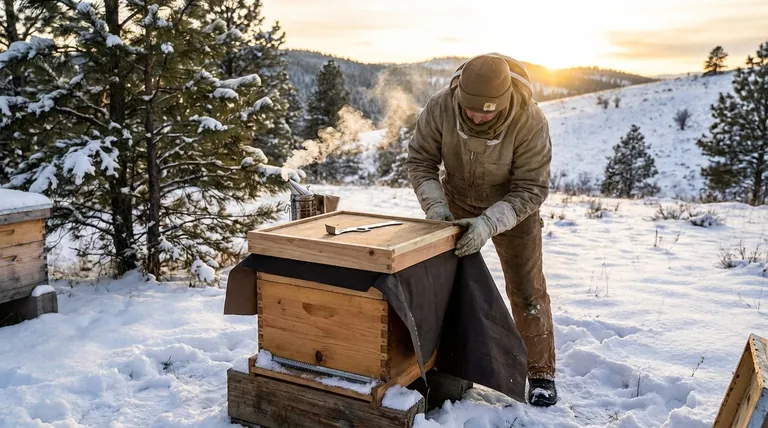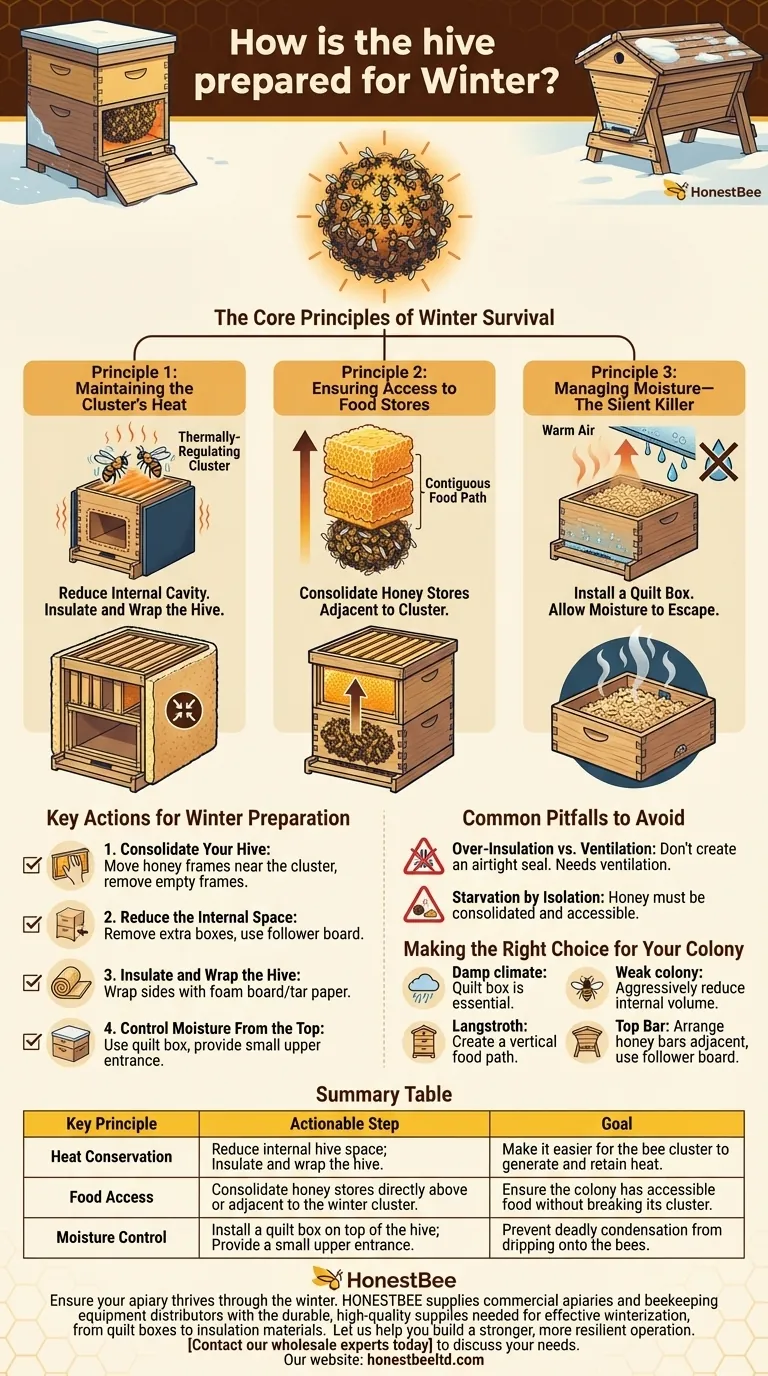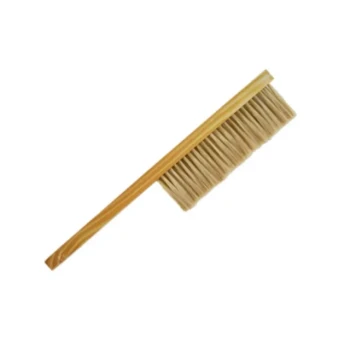To prepare a beehive for winter, you must create a warm, dry, and compact space with ample food right next to the bee cluster. This involves insulating the hive, managing internal moisture, reducing the cavity size to match the smaller winter population, and arranging honey stores so the bees can easily access them without breaking their heat-generating cluster.
The goal of winterization is not just to keep bees warm, but to manage the two greatest threats to their survival: starvation and moisture. A successful strategy creates a compact, dry home where food is always within reach of the colony's central heat cluster.

The Core Principles of Winter Survival
Understanding why certain preparations are necessary is crucial for adapting them to your specific climate and colony. The bees' survival depends on three key factors.
Principle 1: Maintaining the Cluster's Heat
As temperatures drop, honey bees form a tight thermally-regulating cluster. They shiver their flight muscles to generate heat, keeping the queen and core of the cluster at a stable temperature.
Your job is to make this process as energy-efficient as possible. A smaller, well-insulated space is much easier for the bees to heat than a large, drafty one. This is why we reduce the internal cavity of the hive to match the smaller winter bee population.
Principle 2: Ensuring Access to Food Stores
The honey stored in the hive is the fuel for the winter cluster's heat generation. A colony can starve to death with honey just a few inches away if it becomes too cold for the cluster to move.
The honey must be consolidated adjacent to the brood nest. In a vertical Langstroth hive, this means the cluster starts at the bottom and moves upward into honey stores. In a horizontal Top Bar hive, the cluster moves laterally along the bars into the honey. The key is that the food is a contiguous, uninterrupted path.
Principle 3: Managing Moisture—The Silent Killer
A bee colony exhales a significant amount of warm, moist air through respiration. When this air hits a cold inner surface of the hive, it condenses into water. Cold, dripping water on the cluster is a death sentence.
Proper winterization ensures this moisture can escape. A quilt box—a shallow box filled with absorbent material like straw or wood shavings—placed on top of the hive provides insulation while also absorbing moisture and allowing it to vent.
Key Actions for Winter Preparation
Based on these principles, here are the essential steps for preparing your hive.
Consolidate Your Hive
Before it gets cold, inspect your hive and rearrange frames. Move frames of honey from the outer edges of the hive and place them directly above or next to where the main cluster will form. Remove frames that are mostly empty.
Reduce the Internal Space
For a Langstroth hive, this may mean reducing the colony down to two boxes instead of three. For a Top Bar hive, you will move the follower board to shrink the hive cavity, corralling the bees and their food into a smaller, more manageable space.
Insulate and Wrap the Hive
Wrapping the four sides of the hive with a material like foam board or tar paper helps reduce heat loss. This insulation shields the hive from cold winter winds and helps the bees conserve the energy they generate.
Control Moisture From the Top
Place a quilt box on top of the uppermost hive box. This layer of straw, mulch, or wood shavings provides critical top-down insulation and, more importantly, wicks away the moisture the colony produces, keeping the bees dry.
Common Pitfalls to Avoid
Even with the best intentions, mistakes can undermine your efforts.
Over-Insulation vs. Ventilation
The goal is to insulate, not to create an airtight seal. The hive needs some ventilation to allow moist air to escape. Many beekeepers provide a small upper entrance to ensure moisture can vent and to give bees a way out if the bottom entrance becomes blocked by snow or dead bees.
Starvation by Isolation
Simply having enough honey in the hive is not enough. If the honey is not consolidated correctly, the cluster can consume all the food in its immediate vicinity and be unable to move across empty frames to reach more stores, causing them to starve.
Making the Right Choice for Your Colony
Your specific actions should be tailored to your hive type and climate.
- If your primary focus is moisture control in a damp climate: A properly installed quilt box is your single most important tool.
- If you have a smaller or weaker colony: Aggressively reducing the hive's internal volume is critical to help them conserve heat.
- If you are using a Langstroth hive: Your goal is to create a vertical food path, consolidating honey stores in the box directly above the winter cluster.
- If you are using a Top Bar hive: Arrange honey bars adjacent to the cluster and use the follower board to create a snug, compact cavity.
By managing heat, food, and moisture, you give your bees the best possible chance to emerge strong and healthy in the spring.
Summary Table:
| Key Principle | Actionable Step | Goal |
|---|---|---|
| Heat Conservation | Reduce internal hive space; Insulate and wrap the hive. | Make it easier for the bee cluster to generate and retain heat. |
| Food Access | Consolidate honey stores directly above or adjacent to the winter cluster. | Ensure the colony has accessible food without breaking its cluster. |
| Moisture Control | Install a quilt box on top of the hive; Provide a small upper entrance. | Prevent deadly condensation from dripping onto the bees. |
Ensure your apiary thrives through the winter. HONESTBEE supplies commercial apiaries and beekeeping equipment distributors with the durable, high-quality supplies needed for effective winterization, from quilt boxes to insulation materials. Let us help you build a stronger, more resilient operation. Contact our wholesale experts today to discuss your needs.
Visual Guide

Related Products
- HONESTBEE Advanced Ergonomic Stainless Steel Hive Tool for Beekeeping
- Professional Dual-End Stainless Steel Hive Tool for Beekeeping
- Inner Beehive Cover for Beekeeping Bee Hive Inner Cover
- Professional 3-Bar Frame Grip with Integrated Hive Tool
- Professional Galvanized Hive Strap with Secure Locking Buckle for Beekeeping
People Also Ask
- What is the hole in a hive tool for? A Multi-Tool for Apiary Repairs and Maintenance
- What are the features of a regular hive tool? The Essential Multi-Tool for Every Beekeeper
- Why is it important to compare the progress of different hives? A Beekeeper's Key Diagnostic Tool
- What are the basic tools for beekeeping? Essential Starter Kit for Safe & Successful Hive Management
- How should beekeepers handle bees when using a hive tool? Master Calm, Deliberate Techniques



















